.jpg)
A.2) Lowstand Systems Tract (LST)
In sequential stratigraphic, turbidite deposition occurs primarily in the lowstand systems tracts of stratigraphic sequence-cycles. They are mainly deposited during relative sea level falls. In fact, seaward of the shelf break, the space available for the sediments (water depth) is so big that it is insensitive to sea level changes. As the understanding of Vail's turbidite model relies on the comprehension of the lowstand systems tract, a quick overview is given below.
As said previously and illustrated below, a lowstand systems tract is composed of three members in which turbidite deposits are paramount :
(i) Basin Floor Fan (BFF) ;
(ii) Slope Fan (SF) and
(iii) Lowstand Prograding Wedge (LPW).
Note that all these turbidites are lowstand deposits, that is to say, they are deposited with a sea level below the shelf break, what exclude all turbidite deposited during highstand geological conditions as presupposed in certain turbidite Mutti's systems.

As illustrated on this sketch, several types of turbiditic deposits may occur within lowstand systems tracts (LST). In the lower member, i.e., in a basin floor fan (BBF), the following turbidite depositional systems can be found : (i) Amalgamated basinal turbidites ; (ii) Unamalgamated turbidites ; (iii) Sheet lobe facies ; (iv) Channelized facies ; (v) Basin floor thin bedded turbidites and (vi) Contourites. In a slope fan (SF), one can find: (i) Overbank deposits ; (ii) Distal overbank mudstones and (iii) Channel sands with associated (iv) Canyon fills and slump blocks. In the lowstand prograding wedge (LPW), shingled turbidites are often found at the toe of the slope progradations.
- Basin floor fans (BFF) or lowstand basin floor fans, as Vail later called them (to refute Mutti's objections), are associated with the time of rapid eustatic fall, i.e., when sea level falls below the shelf break and sediments are transported across the shelf in incised valleys and rapidly dumped into the basin.
- Lowstand fan sand lobes may develop as relatively isolated lobes or as huge accumulations of virtually basinwide extend. On the other hand, they can be attached to the other members of the lowstand systems tract or completely disconnected as illustrated below.
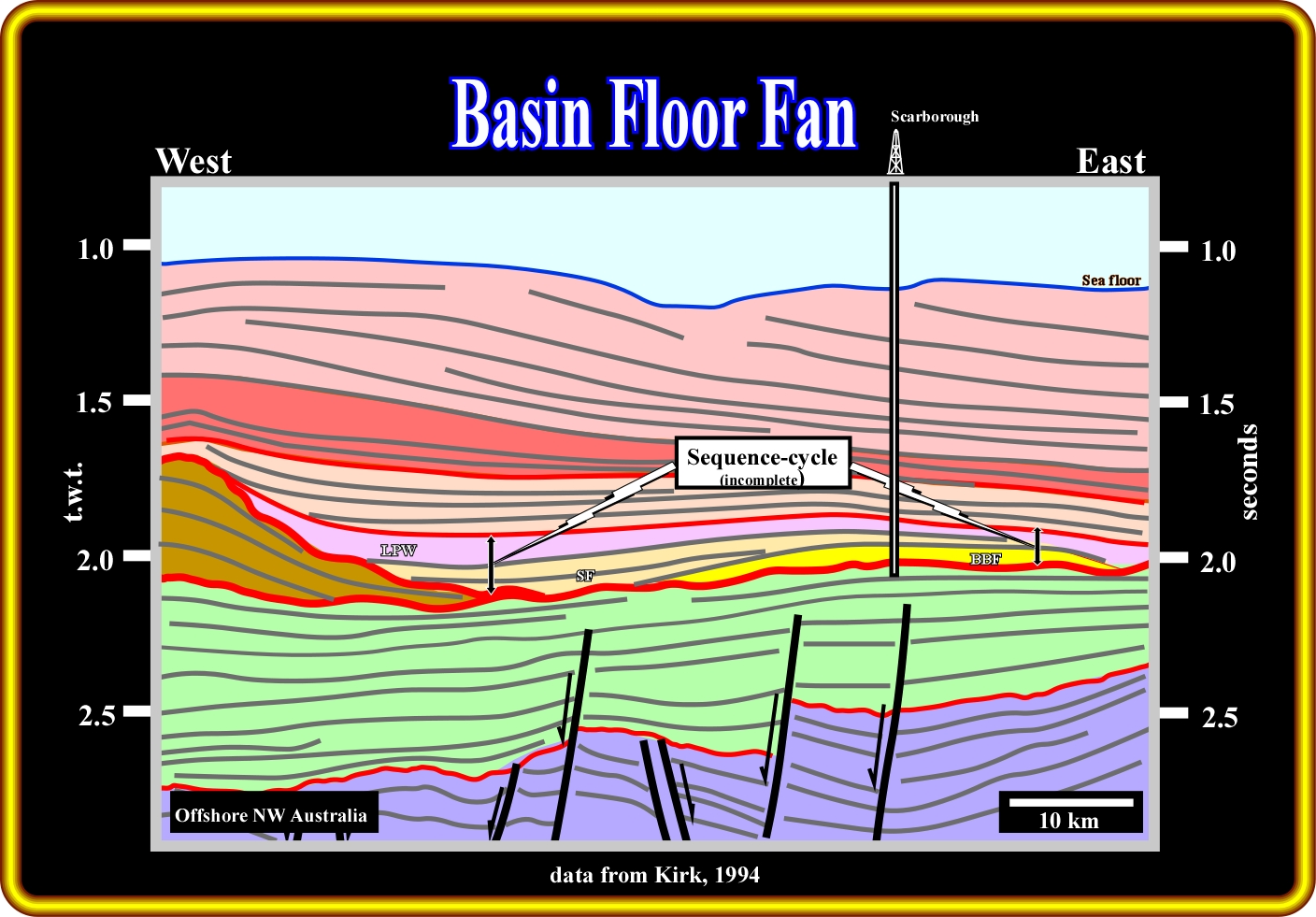
On this geological tentative interpretation of a seismic line of the NW Australia offshore, above a sequence-cycle lower boundary (1.6-2.0 seconds), a basin floor fan (BFF), in yellow, is fossilized by the associated slope fan (SF), in purple, and the lowstand prograding wedge (LPW), in beige. In this particular example, as the basin floor fan (BFF) is covered by the distal shaleprone part of the slope fan (SF) and, eventually also by the lowstand prograding wedge (LPW), it forms a robust morphological trap for hydrocarbons. In fact, this morphological traps was tested and a significant amount of hydrocarbons was discovered (6-12 TCF).
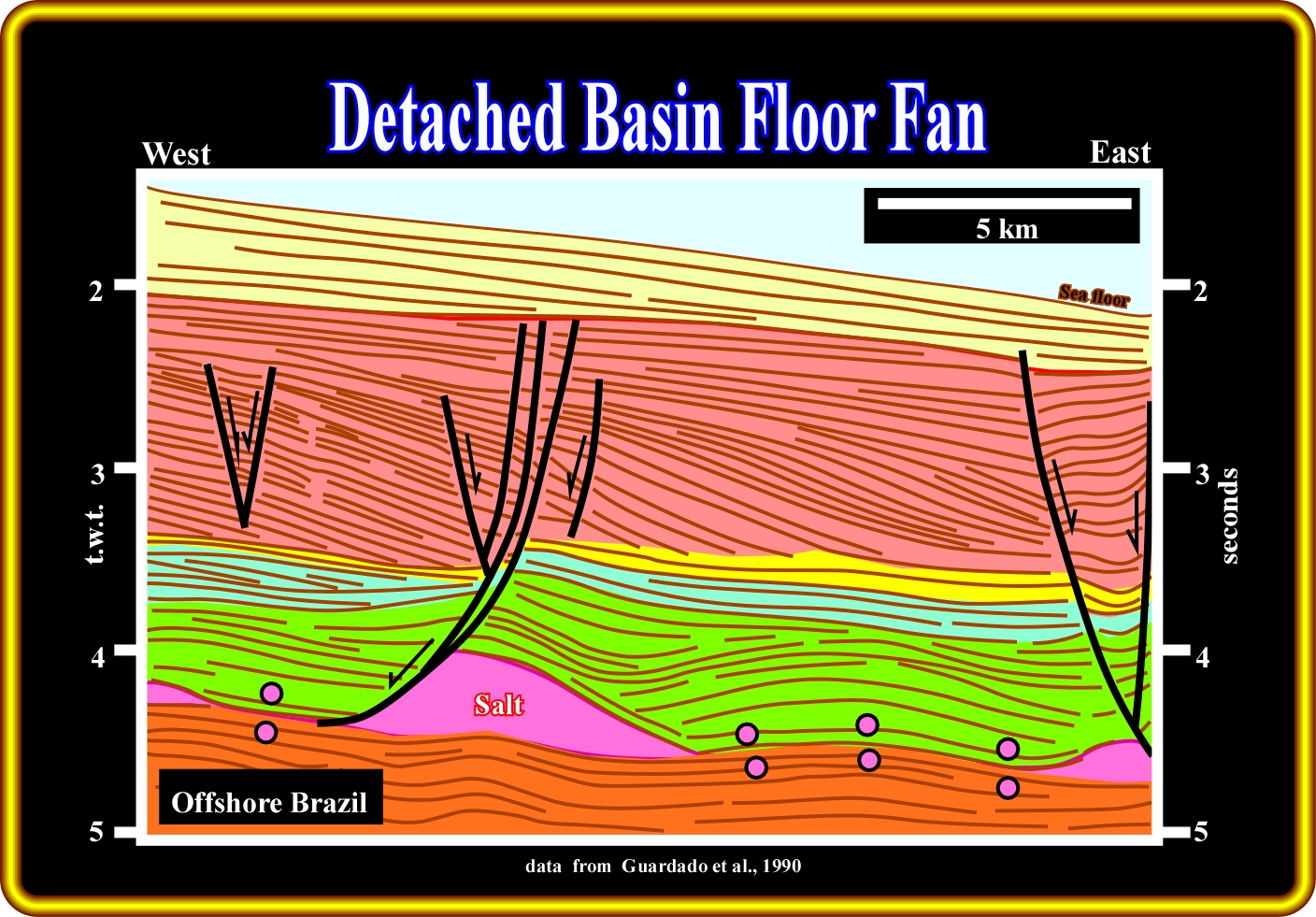
On this tentative geological interpretation of a seismic line of Brazil offshore, a basin floor fan (coloured in yellow) is fossilized by a progradational interval. Assuming that the progradational interval corresponds to a highstand forestepping of a continental slope (HST) and that the basin floor fan (BFF) was deposited during lowstand geological conditions, the basin floor fan must be completely detached from the others members of the lowstand systems tract (LST). The associated lowstand slope fan (SF) and the lowstand prograding wedge (LPW) must be recognized on more proximal seismic lines (westward). If such a conjecture is refuted, a new geological tentative interpretation must be advanced, in which : (i) The progradational interval is a lowstand prograding wedge (LPW) and the basin floor fan corresponds rather to a stack of shingled turbidites or (ii) The basin floor fan is a highstand basin floor and therefore better explained by one of Mutti's turbidite systems than by the Vail's turbidite model.
- The reservoir characteristics of these lowstand lobes depend largely on the matrix porosity and permeability of the sands and their continuity. Internally, each lobe seems to have good continuity and relatively uniform matrix characteristics, except near the lateral and downdip edges of the deposit where sediments become finer grained. However, some deposits are composed of multiple lobes, often derived from different shelf edge sources, which are separated from one another by very continuous pelagic and hemipelagic shales.
- Flow barriers can be expected in such deposits and it becomes important for reservoir development that the individual lobes be carefully described by interpretation of a combination of wells and seismic data. In fact, very often, the initially recoverable reserves attributed to basin floor fan reservoirs decrease strongly after development wells show the presence of pelagic sealing intervals between the different lobes composing the reservoir interval.
- Most very large sand-lobe turbidites that form major oil and gas fields are lowstand fan systems tract sand deposits : Scarborough (before last plate), Frigg (next plates), Halibut, Balder, Marlin (previous), Albacora, Girassol, Plutão, Kuito, etc.. Over twenty billion oil and oil-equivalent barrels have been identified in place in these fields.
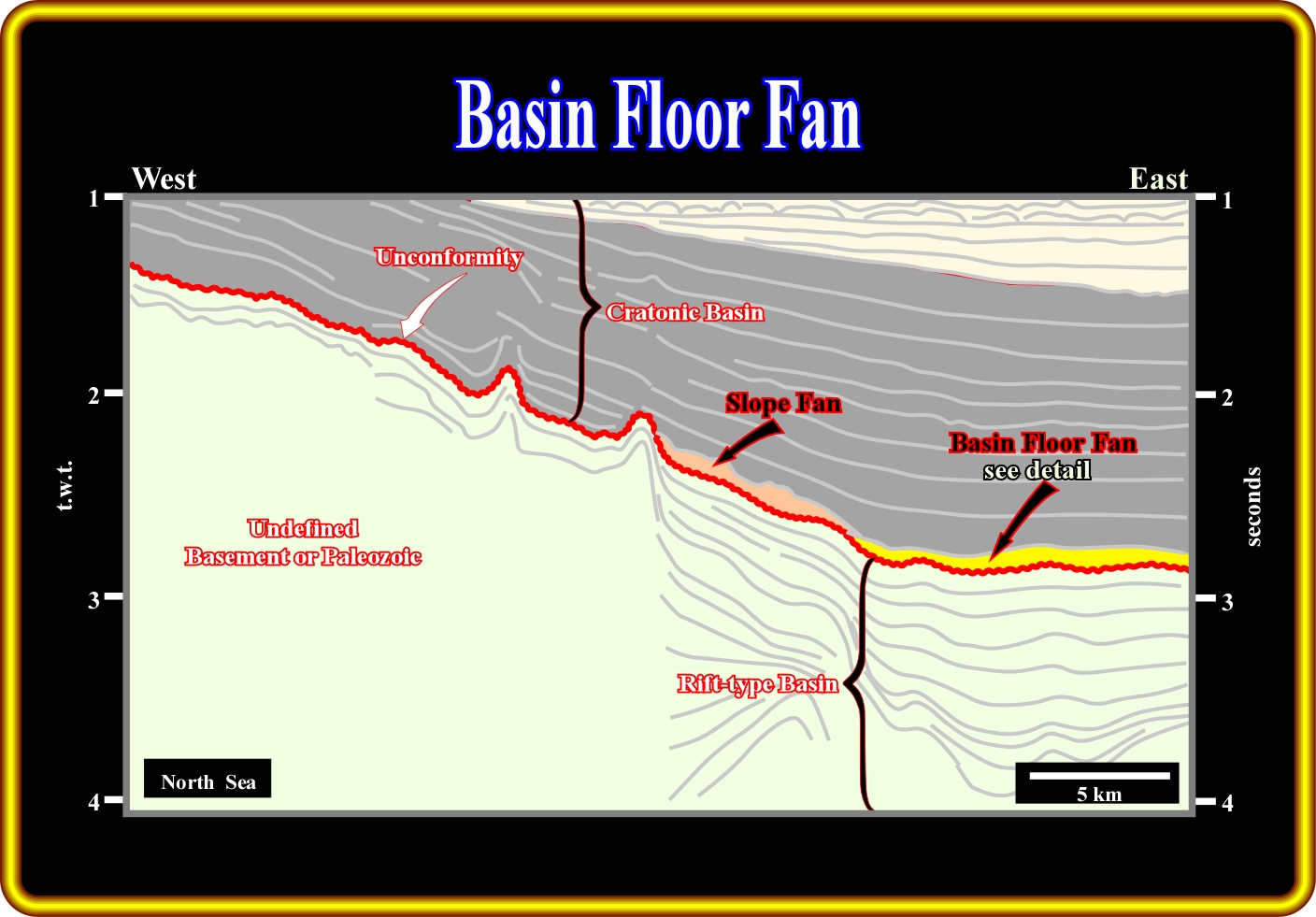
On this geological tentative interpretation of a regional seismic line from the North Sea, a major tectonically enhanced unconformity separates the rift-type basins from the North Sea cratonic basin. The geometry of this unconformity gives roughly the morphology of the base of the cratonic basin. Therefore, the limit between the abyssal plain and the lower slope can be recognized on the right part of the line, by the change in dip of the unconformity. In addition, a basin floor fan (BFF), in yellow, is distinguished at the toe of the continental slope on the abyssal plain, and a slope fan (SF, in beige) at the base of continental slope. The geometric relationships between these fans are better depicted on the close-up shown in the next plate.
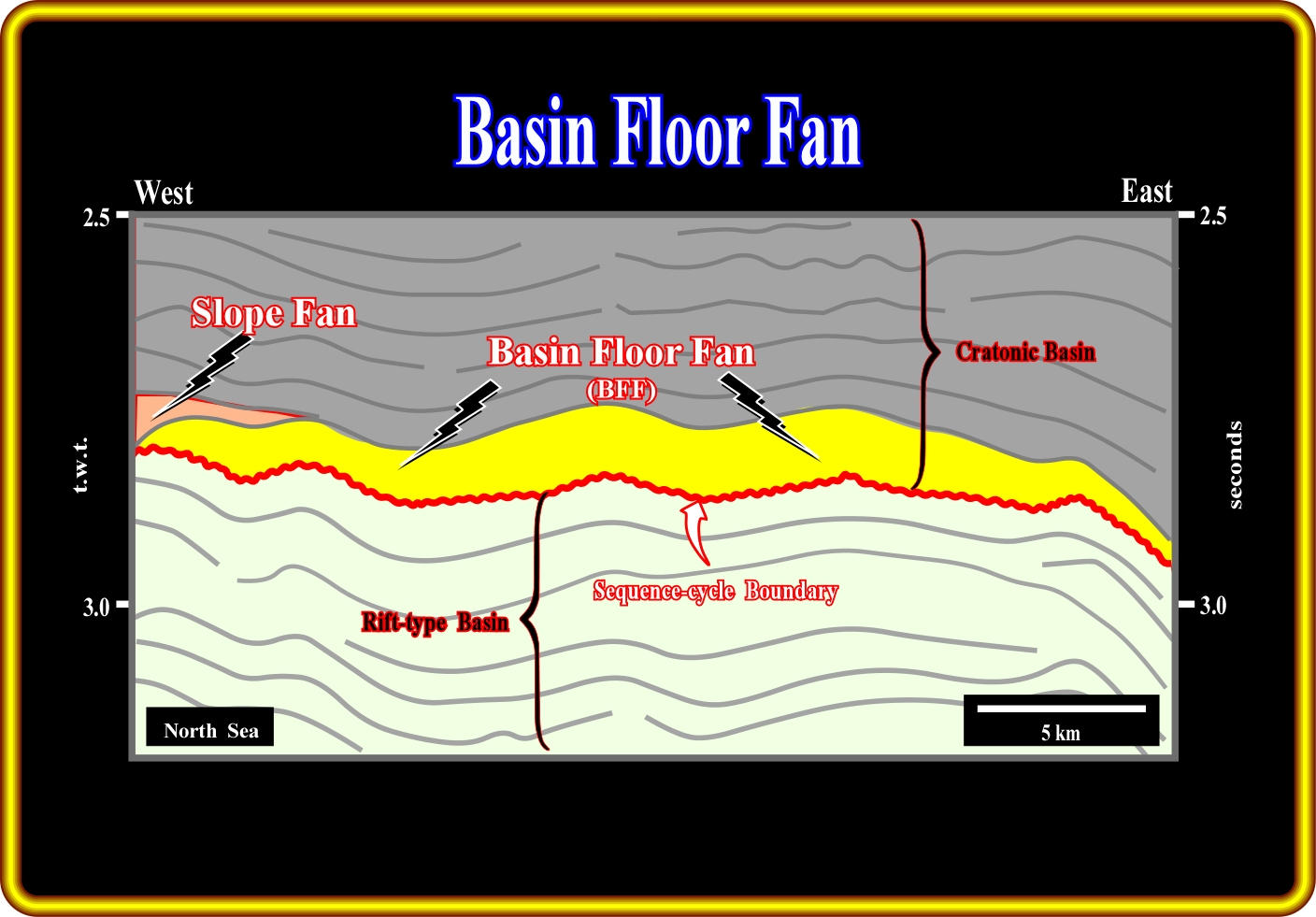
This detail of the geological geological interpretation, illustrated on the previous plate, shows the relationships between the distal part of the slope fan (SF), in beige, and the basin floor fan (BBF), in yellow, which is not completely detached, since its landward edge is fossilized by the seaward overbank deposits of the slope fan. Note that the undulated morphology of the basin floor fan is not real. It is induced by lateral velocity changes and strongly enhanced by the vertical exaggeration. On the other hand, in this particular example, the basin floor fan is reflection free, that is to say, any internal reflectors are evident.
- Basin floor fans can be, under certain conditions, partially eroded by sea floor currents and the liberated sediments redeposited as contourites as illustrated below.
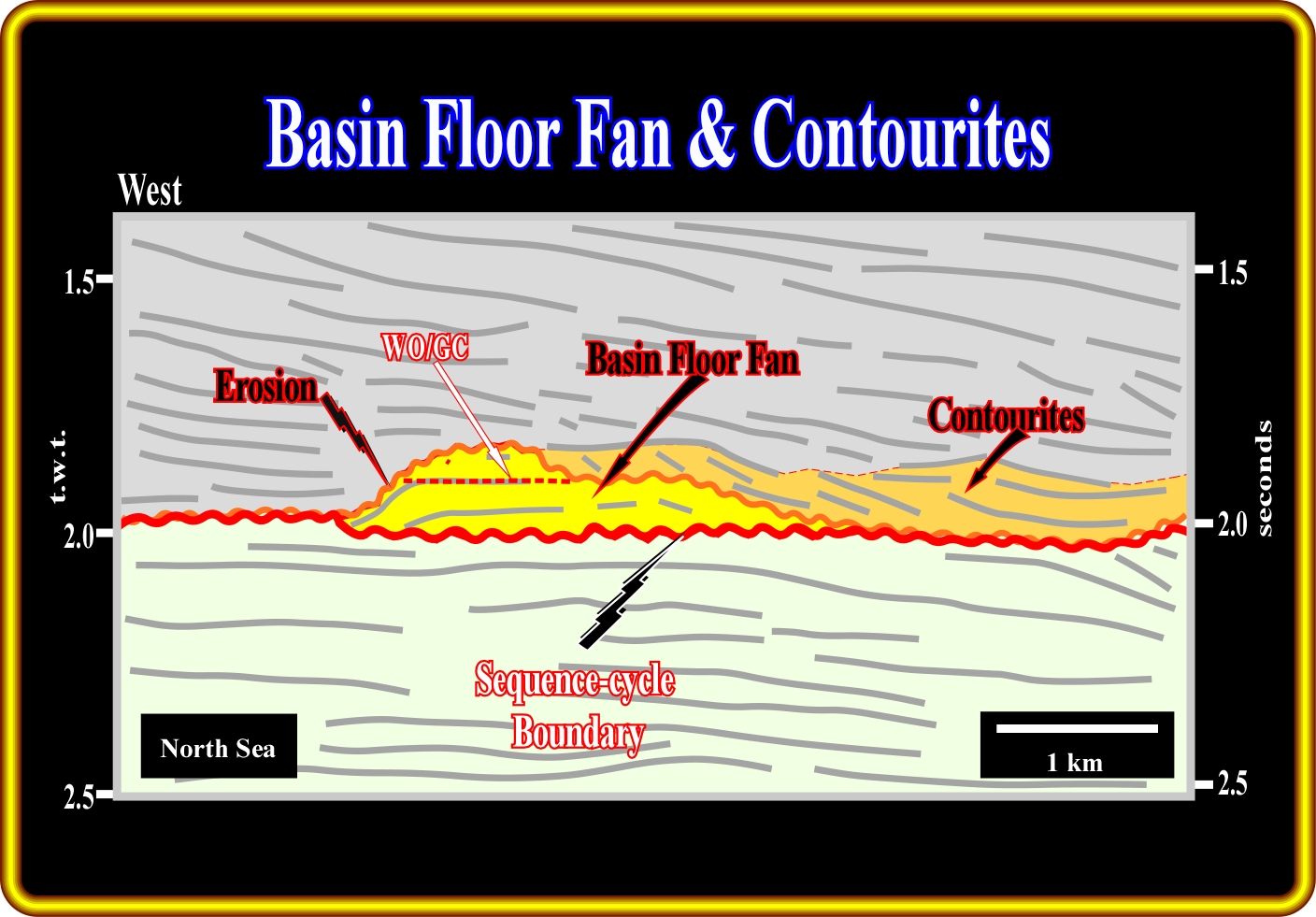
On this close-up of the geological tentative interpretation of a seismic line from the North Sea, illustrated in the plate before last, above a sequence-cycle boundary (unconformity or basinward correlative surface), a basin floor fan (BFF), in yellow, was deposited. However, after being deposited, it was partially eroded and the detached sediments were deposited, not too far, as contourites (orange interval). The reflections within the basin floor fan are, more or less, subhorizontal, while those within the contourites are clearly dipping eastward. The reflector induced by the water-oil plane contact (WO(GC) is roughly parallel to the bedding of the basin floor fan.
- On electrical logs (SP, Gamma ray, Resistivity, Sonic, etc.), basin floor fans exhibit a typical cylindrical pattern as illustrated below.
On this electrical logs (North Sea well), a basin floor fans (BFF) exhibits characteristic patterns with sharp boundaries and thin shale horizons separating massif boxcar sand lobes. The lower limit corresponds to a sequence boundary, while the upper limit corresponds, quite often, to a sharp transition to channel levee complexes of slope fans, when it is attached to the other lowstand systems member.
- Seismic stratigraphic analysis, using eustatic sequential concepts, is one of the best methods of searching for reservoirs and particularly to those associated with basin floor fans. As petroleum exploration moves into deep marine waters, these deposits are among the most promising targets. The exploration applications of the lowstand basin floor fans can be summarized as follows:
(a) RESERVOIR
- Typically excellent k & ø ;
- Continuity variable, often a problem in upper channelized lobes.(b) MIGRATION
- Vertical from deeper sources ;
- Possible downward and lateral from condensed section shales(c) SOURCE
- Leakage from deeper beds ;
- Possible top and condensed section shales.(d) TRAPS
- Typically non structural , generally morphological.
(e) SEAL
- Excellent, pelagic shale of condensed section ;
- Risk of no seal if overlain by slope fan.
Send E-mail to carloscramez@gmail.com with critics, corrections or commentaries on these Turbidite Deposits notes.
Copyright © 2001CCramez
Last modification : November, 2013